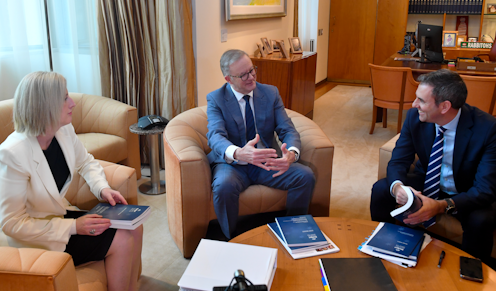
Treasurer Jim Chalmers has said the budget bottom line will be more than $40 billion better over the four-year forward estimates in total than previously forecast.
The forecast for gross debt will also be lower than earlier estimates.
The 2022-23 deficit is forecast to be $36.9 billion, compared to a forecast of $78 billion in the March budget delivered by then-treasurer Josh Frydenberg.
The government says this bottom line improvement is primarily the result of its work to return back to the budget a big majority of the revenue upgrade rather than use it for new spending.
The upgrade has mainly come from higher commodity prices and strong employment numbers and amounts to more than $100 billion over the forward estimates.
Over the four year period, the budget bottom line is estimated to be more than $42 billion better than what was expected in March.
But after an early improvement, the deficits are forecast to worsen towards the end of the forward estimates, compared to earlier forecasts.
This is because the drivers of the revenue upgrades fade and there are surging spending pressures – especially from the National Disability Insurance Scheme and interest payments on debt– substantially higher than forecast in March.
The trend underlines the need for the government to rein in spending in later budgets if it wants to continue budget repair. It has already announced a review of the NDIS, which is headed for a cost of about $50 billion by mid-decade.
On the tax side, the government is hamstrung by election commitments not to change the Stage 3 tax cuts or introduce new taxes. But the budget will see action to prevent multi-nationals’ tax avoidance. This was the one new tax measure Labor promised at the election.
The budget will also show gross debt is lower every year over the forward estimates compared to the March budget numbers.
It will contain a long list of election promises that are being fulfilled, including on child care (a budget centrepiece), cheaper medicine, and additional university and TAFE places. The government says measures such as better child care support and cheaper medicines will help the cost of living pressures people face.
Prime Minister Anthony Albanese said on Monday the budget “deals with cost of living pressures while not putting pressure on inflation”.
Chalmers said: “The primary influence on this budget is inflation. We are putting a premium on restraint and resilience because that’s what the times call for”.
Two Coalition regional programs are set for the scrap heap, while Labor is setting up two of its own.
Infrastructure Minister Catherine King announced the government would not go ahead with the Building Better Regions Fund Round 6. The saving from abolishing this round is about $250 million.
King said the Audit Office had found the grants favoured Nationals’ seats and had been awarded on the basis of rules not made clear to all applicants.
Also to go will be the Community Development Grants program, although there will be a pathway for those CDG projects properly accounted for up to the Pre-election Economic and Fiscal outlook statement to be alternatively funded.
Read more: Floods drive up fruit and veg prices, while energy costs will prolong high inflation
“All contracted projects will be honoured, and a further 82 projects that date back to 2016 and that are yet to be contracted will have six months to finalise negotiations before the program ends,” King’s statement said
Some $1 billion over three years will be devoted to the new regional programs.
A Growing Regions Program will see regional local councils and not-for-profit organisations compete for grants.
A regional Precincts and Partnership Program will provide “a strategic, nationally consistent mechanism for funding and co-ordinating larger-scale projects that transform a place” for regional cities and wider rural and regional areas.
Meanwhile Sky reported on Monday the budget would predict a rise in power prices of 30-40%.
The NSW treasurer Matt Kean said: “I’d like to see the federal government take the national energy issues very seriously and support households with funding and support in this budget”.
Michelle Grattan does not work for, consult, own shares in or receive funding from any company or organisation that would benefit from this article, and has disclosed no relevant affiliations beyond their academic appointment.
This article was originally published on The Conversation. Read the original article.







